Heredity
Genetics is the branch of biology which studies heredity and variation. Inheritance is the transmission
of genetically controlled traits from one generation to the next
Inherited Traits
The traits or characteristics that are transmitted from one generation to the next are controlled by genes. A gene is a segment of DNA which is responsible for the synthesis of proteins that contains a specific character of the organism. An example is the free earlobes and attached earlobes found in human population.
Mendel’s Contributions
Gregor Mendel was the first scientist to make a systematic study of patterns of inheritance which involved the transfer of characteristics from parents to progeny (offsprings). He is known as the Father of Genetics.
![]()
Mendel’s Experiment
Mendel used a number of contrasting visible characters of garden peas – round/wrinkled seeds, tall/short plants, white/violet flowers and so on. He took pea plants with different characteristics – a tall plant and a short plant, produced progeny from them, and calculated the percentages of tall or short progeny. Mendel chose pea plants for studying inheritance because pea plants had a number of distinct differences which were easy to tell apart.
- Availability of detectable contrasting traits of several characters.
- Short life span of the plant.
- Normally allows self-fertilisation but cross-fertilisation can also be carried out.
- Large number of seeds produced.
Monohybrid inheritance:
- It concerns the inheritance of a single plant characteristic such as plant height or color of flowers.
- Mendel first crossed pure-bred tall pea plants with pure-bred dwarf pea plants and found that there were no halfway characteristics or ‘medium-height plants in this first generation, or F1 progeny. All plants were tall.
- Mendel then crossed the tall pea plants of the first generation by self-pollination and found that the second-generation, or F2, the progeny of the F1 tall plants are not all tall. Instead, one-quarter of them were short.
- Both the tallness and shortness traits were inherited in the FI plants, but only the tallness trait was expressed.
- Two copies of the trait are inherited in each sexually reproducing organism. These two may be identical or may be different, depending on the parentage.
- Out of a total of 1064 pea plants of F2 generation, Mendel found that there were 787 tall pea plants and 277 dwarf pea plants. The ratio of tall plants to dwarf plants comes to be approximately 3: 1. The ratio 3 : 1 is known as the monohybrid ratio. e.g., The genotypic ratio of F2 progeny is TT : Tt: tt = 1: 2 : 1.
Example 1.
Case Based:
Let us study further the genotype and phenotype of pea plants in the Fx and F2 generations.
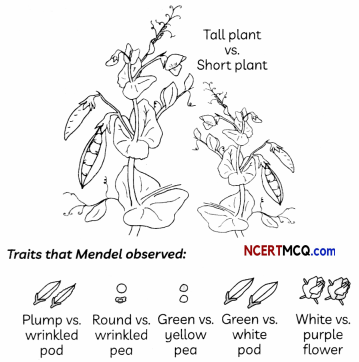
(A) Mendel used a number of contrasting visible characters of a garden pea for his experiments. Select the incorrect pairs of contrasting characters:
(I) Pink / white flower color
(II) Round/Wrinkled pea shape
(III) Green / White pod colour
(IV) Tall/Dwarf plant size
(a) Both (I) and (II)
(b) Both (I) and (III)
(c) Both (II) and (III)
(d) Both (III) and (IV)
Answer:
(b) Both (I) and (III)
Explanation: Mendel used the seven pairs of contrasting characters of pea plants for his experiments which are as follows:
- Pea shape: Round or Wrinkled.
- Pea color: Green or Yellow.
- Pod shape: Constricted or Inflated.
- Pod color: Green or Yellow.
- Flower color: Purple or White.
- Plant size: Tall or Dwarf
- Position of flowers: Axial or Terminal.
(B) The table below gives the phenotypic ratio of Tall: Short pea plants in the F1 and F2 generation.
Select the row containing the correct information:
| F1 Generation | F2 Generation |
| (a) 3: 1 | 1: 3 |
| (b) 4 : 0 | 1: 3 |
| (c) 4 : 0 | 3: 1 |
| (d) 3: 1 | 3 :1 |
Answer:
(c) F1 Generation: 4 : 0; F2 Generation: 3 :1
Explanation: When a pure tall pea plant (TT) is crossed with a pure short pea plant (tt), all plants in the F1 generation will be tall (Tt).
When these tall plants of F1 generation are crossed, 75 % of plants will be tall and 25 % will be short.
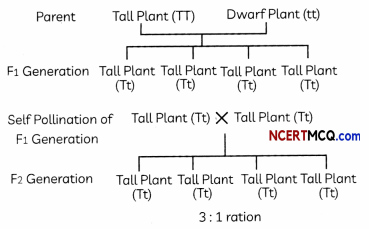
(C) What will be the genotypic ratio of F2 genera¬tion in the above cross?
Answer:
The genotypic ratio of F2 generation in the above cross will be TT: Tt: tt = 1: 2 :1 as all pea plants obtained in the F1 generation were tall having genotype Tt, the genotype ratio in the F2 generation will be TT: Tt: tt = 1: 2 :1, as can be seen from the above diagram.
(D) What experiment can you conduct to verify that the F2 generation did in fact have a 1:2:1 ratio of TT, Tt and tt traits?
Answer:
Let us cross a tall pea plant (obtained in FI generation) with a short pea plant. Genotype of the tall parent will be Tt and that of the short parent tt. We will observe that 50 % of progenies were tall and 50 % were short, which means that the genotype of the tall plant was Tt (and not TT). Its gametes would be T and t, which when crossed with a short plant (tt) would result in 50 % plants with genotype Tt and 50 % with genotype tt.
This type of cross can be used to confirm that the F2 generation did in fact have a 1:2:1 ratio of TT, Tt, and tt trait combinations.
(E) Assertion (A): When pure tall pea plants are crossed with pure short pea plants, the percentage of short pea plants in the first filial generation is 50%.
Reason (R): All plants in the first filial generation will be tall as tallness is dominant.
(a) Both (A) and (R) are true and (R) is the correct explanation of the assertion.
(b) Both (A) and (R) are true, but (R) is not the correct explanation of the assertion.
(c) (A) is true, but (R) is false.
(d) (A) is false, but (R) is true.
Answer:
(d) (A) is false, but (R) is true.
Explanation: When pure tall pea plants are crossed with pure short pea plants, all plants in the first filial generation will be tall. Therefore, the percentage of short pea plants in the Fi generation will be 0%.
![]()
Example 2.
Outline a project which aims to find the dominant coat color in dogs.
Answer:
Select a homozygous black (BB) male dog and a homozygous white (bb) female dog. Allow them to mate and produce offspring (F1 generation). If all of the FI offspring are black, we can conclude that black coat cover is dominant than a white coat in the dog.

Dihybrid inheritance:
1. It concerns the inheritance of characteristics when pea plants showing two different characteristics, rather than just one, are bred with each other.
2. The progeny of a tall plant with round seeds and a short plant with wrinkled seeds are all tall and have round seeds. Tallness and round seeds are thus dominant traits.
3. When these F1 progenies are used to generate F2 progeny by self-pollination, some F2 progeny are tall plants with round seeds, and some were short plants with wrinkled seeds.
(4) There would also be some F2 progeny that showed new mixtures. Some of them would be tall, but have wrinkled seeds, while others would be short, but have round seeds.
(5) The tall/short trait and the round seed/wrinkled seed trait are independently inherited.
Independent Inheritance of two separate traits: In the inheritance of more than one pair of traits in a cross simultaneously, the factors responsible for each pair of traits are distributed independently to the gametes. The dihybrid cross can be shown by drawing a chart as shown:
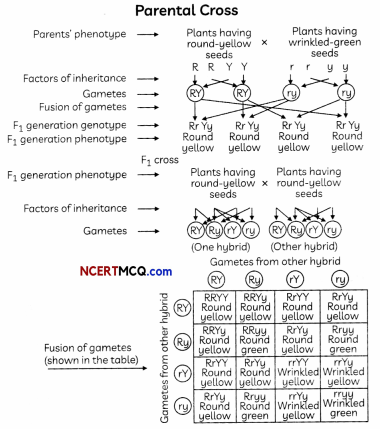
Example 3.
A Mendelian experiment consisted of breeding tall pea plants bearing violet flowers with short pea plants bearing white flowers. The progeny all bore violet flowers, but almost half of them were short. This suggests that the genetic make-up of the tall parent can be depicted as:
(a) TTWW
(b) TTww
(c) TtWW
(d) TtWw
Answer:
(c) TtWW
Explanation: This is a dihybrid cross of a plant involving two characters in the same plant. As the progeny had violet flowers, therefore, the tall plants have genotype WW as violet is dominant. Also, almost half of the plants were short which means that the genotype is Tt.
Important Terms used in Heredity
Chromosome: Chromosomes are the carriers of genes and are long thread-like structures present in the nucleus of a cell. Each gene set is present as separate independent pieces, each called a chromosome.
DNA: Cellular DNA is the information source for making proteins in the cell. DNA is the genetic material. DNA is the carrier of genetic information from generation to generation. Every chromosome contains one molecule of DNA and genes are segments of DNA.
Genes: Gene is a segment of a large molecule called deoxyribonucleic acid (DNA) which forms the most important constituent of chromosome. Genes are located on the chromosomes at fixed positions and their number is estimated to be between 30, 000 to 40, 000. Genes control characteristics or traits.
Allele: One of the different forms of a particular gene occupying the same position on a chromosome.
Factor: The carriers of hereditary information were called as factors by Mendel. He considered each and every character as a unit, which was controlled by a ‘factor’ based on his experiments with garden pea.
F1 generation: When two parents cross or breed to produce progeny, then their progeny is called first filial generation.
F2 generation: When the first generation progeny cross among themselves to produce second progeny, then this progeny is calLed second filial generation.
Diploid: The paired condition of chromosomes is called diploid. The diploid number of chromosomes is specific for a species and every cell has diploid number of chromosomes.
Haploid: It is the set of unpaired chromosomes. Gametes have haploid set of chromosomes.
Homologous chromosome: Members of a pair of chromosomes are exactly identical as far as shape and size are concerned and hence called homologous chromosomes.
Genotype: It is the description of genes present in an organism. It is always a pair of letters such as TT, Tt or tt (where T and t are the different forms of the same gene).
Phenotype: The characteristic or trait which is visible in an organism is called its phenotype. Being tall or dwarf are phenotypes of a plant as these traits are visible.
Dominant and recessive traits: In this explanation, both TT and Tt are tall plants, while only tt is a short plant, in other words, a single copy of T is enough to make the plant tall, while both copies have to be ‘t’ for the plant to be short. So, a tall plant will have genotype TT or Tt, whereas a short plant will have genotype tt. Traits like T are called dominant traits or expressed traits, while those that behave like ‘t’ are called recessive traits or repressed traits.
![]()
Mendel’s Laws of Inheritance
| Law | Definition |
| Law of Segregation | During gamete formation, the alleles for each gene segregate from each other so that each gamete carries only one allele for each gene. |
| Law of Independent Assortment | Genes for different traits can segregate independently during the formation of gametes. |
| Law of Dominance | Some alleles are dominant while others are recessive; an organism with at least one dominant allele will display the effect of the dominant allele. |
Expression of Traits
Genes control characteristics or traits in all organisms. Cellular DNA is the information source for making proteins in the cell. Each trait is governed by a particular hormone and the amount of the hormone made depends on the efficiency of the process for making it which in turn depends on a particular enzyme that is important for this process. If this enzyme works efficiently, a lot of hormones will be made and if the gene for that enzyme has an alteration that makes the enzyme less efficient, the amount of hormone will be less.
Example 4.
A study found that children with light-colored eyes are likely to have parents with light-colored eyes. On this basis, can we say anything about whether the light eye color trait is dominant or recessive? Why or why not?
Answer:
No, we cannot say with certainty about whether the light eye color trait is dominant or recessive without knowing the genotype of the variants. Moreover, at least three generations are required for determining whether trait is dominant or recessive.
![]()
Example 5.
A man with blood group A marries a woman with blood group O and their daughter has blood group O. Is this information enough to tell you which of the traits – blood group A or O – is dominant? Why or why not?
Answer:
The given information is not enough to tell us which of the traits – blood group A or O – is dominant, in blood heredity, blood Type A is always dominant and blood Type 0 is always recessive.
Father’s Blood group can be AA (homozygous) or AO (heterozygous), and that of mother can be OA or 00. For daughter to be born with blood group O, she must receive O type gene one each from father and mother. For this father must have a heterozygous AO blood group and mother must have a homozygous blood group 00.
Related Theory:
Research carried out in Heidelberg, Germany by Ludwik Hirszfeld and Emil von Dungern in 1910 and 1911 showed that the ABO blood types are inherited. An individual’s ABO type results from the inheritance of 1 of 3 alleles (A, B, or C) from each parent. The possible outcomes are shown below:
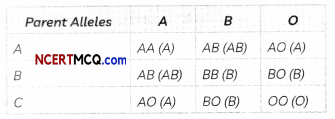
Both A and B alleles are dominant over O. As a result, individuals who have an AO genotype will have an A phenotype. People who are type O have 00 genotypes. In other words, they inherited a recessive O allele from both parents. The A and B alleles are codominant. Therefore, if an A is inherited from one parent and a B from the other, the phenotype will be AB. Agglutination tests will show that these individuals have the characteristics of both type A and type B blood.
Mechanism of Inheritance
The rules for the inheritance of traits in sexually reproducing organisms are related to the fact that both the parents contribute practically equal amounts of genetic material to the offspring. This means that each trait can be influenced by both paternal and maternal DNA. Thus, for each trait there w: T be two versions in each offspring.
Every germ cell takes one chromosome from each pair and these may be of maternal or parental origin. When two germ cells combine, they will restore the normal number of chromosomes in the progeny and in this way the DNA of the species becomes stable.
Example 6.
How is the equal genetic contribution of male and female parents ensured in the progeny?
Answer:
In human beings, equal genetic contribution of male and female parents is ensured in the progeny through inheritance of equal number of chromosomes from both parents. The chromosome number is halved during gamete formation.
During the course of reproduction, as fertilization process takes place, the male gamete (haploid) fuses with the female gamete(haploid) resulting in formation of the diploid zygote. The zygote in the progeny receives an equal contribution of genetic material from the parents.
![]()
Sex Determination
In human beings, the sex of the offspring in the zygote after fertilization of the male and female gamete is determined by the sex chromosome. The rest of the chromosomes are called autosomes. Human beings have 22 pairs of autosomes and one pair of sex chromosomes. The females carry two X- chromosomes but the males carry a single X and a Y chromosome. Among the male gametes, half of the sperms carry X-chromosome and half carry Y-chromosome. In human beings, the sex of the individual is largely genetically determined.
- When a sperm carrying X-chromosome fertilizes an egg, the zygote develops into female (XX).
- When a sperm carrying Y-chromosome fertilizes an egg, the zygote develops into male (XY).
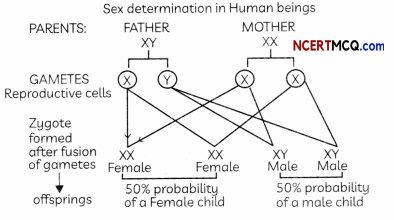
Effect of environmental factors on sex determination:
In some reptiles, the temperature at which the fertilized egg is incubated before hatching is important for sex determination.
- In a turtle high incubation temperature results in the development of female progeny.
- In the case of lizard, high incubation temperature results in the development of male progeny.